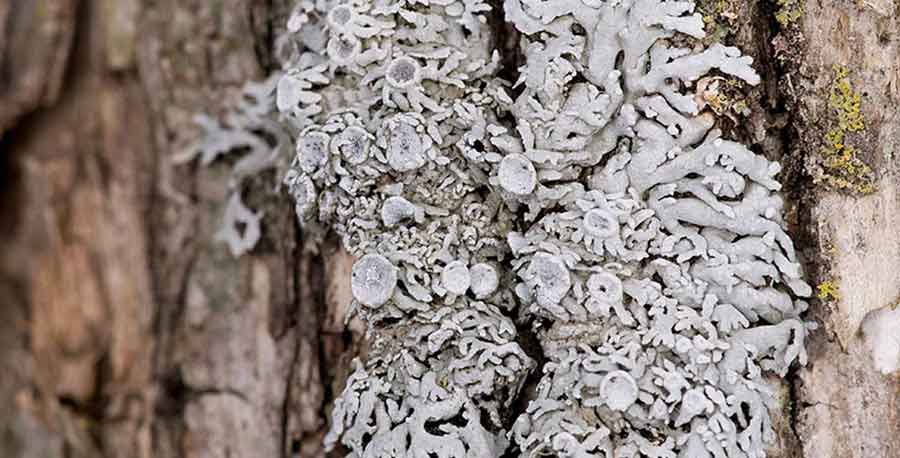Pale-bellied Frost Lichen

Introduction
This chapter provides a review of progress toward protection and recovery of Pale-bellied Frost Lichen in Ontario from 2007 to 2015.
Species information
Pale-bellied Frost Lichen (Physconia subpallida) is a pale to bright white, crust-like growth that can look like frost on a tree trunk. The species can be distinguished by its circular rosettes which grow three to four centimetres in diameter.
Pale-bellied Frost Lichen is known to occur in Frontenac, Haliburton, Hastings, Peterborough, Lanark and Renfrew counties. In Canada, Pale-bellied Frost Lichen occurs only in southern Ontario. Pale-bellied Frost Lichen grows on the bark of trees in mature deciduous forests with high levels of fog or humidity and moderate to high levels of shade. The species generally prefers to grow on thick-barked Eastern Hop-hornbeam trees.
Pale-bellied Frost Lichen faces several threats to its survival and recovery. Loss and degradation of suitable habitat, especially due to air pollution, is one of the main threats to Pale-bellied Frost Lichen. The species is also particularly vulnerable to some effects of climate change. For example, warmer air temperatures threaten Pale-bellied Frost Lichen because warmer temperatures change humidity levels and the frequency and length of fog periods on which the species depends. Because the species exists in a limited number of locations, it is also more vulnerable to disturbance events such as ice storms or fire.
Pale-bellied Frost Lichen is listed as endangered at both the provincial (Species at Risk in Ontario List) and the federal (Schedule 1 under the Species at Risk Act) levels. Globally, the species is not yet ranked.
Provincial status
The Committee on the Status of Species at Risk in Ontario (COSSARO) assessed Pale-bellied Frost Lichen as endangered. Following this assessment, it was added to the Species at Risk in Ontario List in 2010. In future assessments, COSSARO may consider information gained through protection and recovery actions regarding the species’ threats and trends in population and distribution.
Species and habitat protection
Protecting Pale-bellied Frost Lichen and its habitat are key components in the implementation of the Endangered Species Act, 2007 (ESA or “the Act”), and continue to be government-led actions, as identified in the government response statement. As an endangered species, Pale-bellied Frost Lichen has been protected from being killed, harmed, harassed, captured or taken under the ESA since it was listed in 2010. In addition, the species’ habitat has been protected from being damaged or destroyed since 2010. Habitat protection for the species was initially based on the general habitat definition in the ESA. The habitat of Pale-bellied Frost Lichen is now protected through a habitat regulation that came into force in 2012.
The government developed the habitat regulation (Ontario Regulation 242/08, section 28.2) for Pale-bellied Frost Lichen within the timeframe required by the ESA. The habitat regulation provides clarity to the public and others on what areas are protected as Pale-bellied Frost Lichen habitat. The regulated habitat includes areas that are required by the species to carry out its life processes within its range in Ontario. The habitat regulation was developed based on information regarding the habitat needs of the species as well as social and economic factors, collected from a variety of sources including comments received through public consultation. Any person who negatively impacts Pale-bellied Frost Lichen or its habitat without prior authorization may be prosecuted under the ESA.
Pale-bellied Frost Lichen has been protected from being killed, harmed, harassed, captured or taken since 2010.
In addition, the habitat of Pale-bellied Frost Lichen has been protected from being damaged or destroyed since 2010. Habitat protection was initially based on the general habitat definition in the ESA. The habitat of Pale-bellied Frost Lichen is now protected through a habitat regulation that came into force in 2012.
Recovery strategy
A recovery strategy for Pale-bellied Frost Lichen was published on February 18, 2011, which was in advance of the date required by the ESA. Recovery strategies are advice to government and represent the best available scientific knowledge. The strategy identifies Pale-bellied Frost Lichen habitat needs and the threats that it faces, while recommending objectives and approaches for protecting and recovering the species. The recovery strategy also includes recommendations on the areas of habitat to be considered in the development of a habitat regulation.
Government response statement
The Ministry of Natural Resources and Forestry (“MNRF” or “the Ministry”) published the government response statement (GRS) for Pale-bellied Frost Lichen on November 18, 2011, which was within the timeframe required by the ESA. The GRS is government policy that contains the Government of Ontario’s goal for the recovery of Pale-bellied Frost Lichen.
To help achieve this goal, the government leads and supports recovery actions identified in the GRS. Common actions for the government to lead as it works toward achieving a species’ recovery goal are provided in section 2.5 of the Species at Risk Program Status (2008–2015). The GRS for Pale-bellied Frost Lichen also lists seven actions the Ministry supports others to undertake for the species. These government-supported actions fall under the objectives identified in the GRS, which are:
Recovery Goal
The government’s goal for the recovery of the Pale-bellied Frost Lichen is to ensure the persistence of the size and distribution of all existing populations of the species in Ontario and to allow for natural population growth through maintenance of suitable occupied and adjacent habitat.- Protect individuals and habitat at all known locations of Pale-bellied Frost Lichen;
- Determine the distribution, abundance, and population trends of Pale-bellied Frost Lichen;
- Conduct research to address knowledge gaps for Pale-bellied Frost Lichen; and
- Increase awareness of landowners, municipalities, and planners through communication and outreach.
through the general habitat definition under the ESA in 2010 and then a habitat regulation in 2012
Government funded projects
An important government-led action in the GRS for Pale-bellied Frost Lichen is to support partners to undertake activities to protect and recover the species. Through the Species at Risk Stewardship Fund the Ministry has supported two projects ($61,390) designed to contribute to the protection and recovery of Pale-bellied Frost Lichen. Both of these projects targeted multiple species at risk, including Pale-bellied Frost Lichen, and partners reported that they were successful in securing additional funding ($85,660) from other sources. This amount includes additional funding and in-kind support in the form of time and expertise provided by volunteers.
Stewardship partners reported that provincial funding helped them to secure in-kind support by involving 76 individuals who volunteered 1,523 hours of their time toward protection and recovery activities for multiple species at risk, including Pale-bellied Frost Lichen, which has an estimated value of $53,240. In addition, the partners reported providing outreach on multiple species at risk, including Pale-bellied Frost Lichen, to 220 individuals.
The remainder of this section highlights two projects that were supported through the Species at Risk Stewardship Fund and their corresponding government-supported recovery actions.
Two projects involving Pale-bellied Frost Lichen supported the GRS action of conducting surveys to find Pale-bellied Frost Lichen at sites adjacent to the currently occupied forest stands, at historic locations and in suitable habitat within the species range. Of the two projects, one was successful in finding the species. This project was completed by the Canadian Wildlife Federation (CWF). CWF enlisted a species expert to survey nearly all previously known locations of the species and suitable habitat surrounding these locations. These efforts resulted in the identification of Pale-bellied Frost Lichen at 10 previously known sites. This information was then used to monitor the extent of the populations and to search nearby areas for additional occurrences, which led to the identification of one new location of the species. Photos of the species were taken at each site to document the extent of occupancy, the habitat, growth form and the host species. In addition to conducting surveys for the species, the project supported a quantitative census of known populations of Pale-bellied Frost Lichen and helped to determine the forest stand characteristics at each site where Pale-bellied Frost Lichen occurs, which are both listed as actions in the species’ GRS.
Surveying for species at risk — the MNRF forest values collection project
Under the Crown Forest Sustainability Act, MNRF is responsible for the long-term health of Ontario’s crown forests. Through forest management planning, forest managers maintain healthy forests that offer a range of sustainable benefits (e.g., timber and commercial products, wildlife habitat and recreational opportunities). In order to be approved, a forest management plan must describe how the forest will be managed sustainably, including plans for “values” such as plant life, animal life, soil, and water. MNRF is responsible for collecting and maintaining values information, and to provide this information to Sustainable Forest License (SFL) holders or other plan holders. In 2015, the forest values collection project was created to assist in collecting this values information for MNRF’s Southern Region. This work takes place in southeast Ontario where the only Forest Management Units in southern Ontario exist. The goal of this project is to collect information on 10 species including the following species at risk: Blanding’s Turtle, Wood Turtle, American Ginseng, Pale-bellied Frost Lichen, Massassuaga Rattlesnake and Common Five-lined Skink. The project was conducted by three crews from the southern Ontario region of MNRF in collaboration with staff from the Bancroft, Pembroke, Parry Sound and Kemptville MNRF district offices as well as Algonquin Park. In 2015, crews completed 1,200 surveys, collected over 830 values, surveyed over 80 water crossings and identified 17 unmapped streams, trained over 125 MNRF staff on survey protocols and engaged another 200 staff. As part of the values collection surveys, MNRF staff successfully found 19 Pale-bellied Frost Lichen in 2015 and over 22 Pale-bellied Frost Lichen in 2016 at multiple locations.
Species at Risk Stewardship Fund
-
 $0
$0for Pale-bellied Frost Lichen exclusively
-
 $61,390
$61,390for multi-species projects that included Pale-bellied Frost Lichen
-
 $85,660
$85,660in additional funding and in-kind support
-
 2
2projects included the Pale-bellied Frost Lichen
-
 76
76volunteers
-
 1,523
1,523volunteer hours
-
 220
220people received outreach
Efforts to minimize adverse effects on Pale-bellied Frost Lichen
Supporting partners through permits and their associated conditions, is an important government-led action. To date, no permits have been issued for Pale-bellied Frost Lichen.
Five activities that may affect Pale-bellied Frost Lichen or its habitat have been registered under ‘Drainage works’ (section 23.9) of Ontario Regulation 242/08. The five activities include carrying out drainage and ditch work, including improvement, maintenance and repair. These registrations require the registered individual to comply with all conditions of the regulation, such as:
- Taking immediate steps to minimize adverse effects on the species and its habitat (e.g., establishing protective zones around habitat areas);
- Implementing the actions in a mitigation plan developed by an expert on the species (e.g., habitat restoration or improvement actions);
- Reviewing and updating mitigation plans every five years to adjust/strengthen mitigation actions as required; and
- Preparing an annual report to record all observations of the species and describe the steps taken to minimize adverse effects on the species.
5 registrations
Occurrences of Pale-bellied Frost Lichen in Ontario
Natural Heritage Information Centre (NHIC)
There are 29 known populations
Since 2008, the Ministry has received 113 observations of the species. These records are based on observations between 1868 and 2016 and come from a variety of sources. The records have helped to broaden our understanding of where the species is known to occur and have contributed to assessments of population viability. For example, according to the NHIC, only three extant and four historical populations of Pale-bellied Frost Lichen were known to exist before 2011. Since 2011, observations submitted to the NHIC have helped discover 22 new populations of Pale-bellied Frost Lichen. Three populations that had previously been considered historic have now been classified as extirpated or possibly extirpated; however, one population of the species that had not been observed since 1868 was found in 2015 and is now considered to be extant. It is possible that there are observations of Pale-bellied Frost Lichen that have not been submitted to the Ministry. Encouraging the submission of observations of Pale-bellied Frost Lichen to the Ministry is included in the GRS as a government-led action.
According to the Committee on the Status of Endangered Wildlife in Canada (COSEWIC) Pale-bellied Frost Lichen experienced a dramatic decline in the early 1990s, mainly due to air pollution. The 2009 COSEWIC status report for the species states that improvements in air quality have led to decreased sulfate deposition which may allow Pale-bellied Frost Lichen populations to expand in the longer-term. The recent increase in NHIC observations of the species and the identification of several new populations are likely a result of increased search effort and education about Pale-bellied Frost Lichen and may not represent increases to the total population, but rather increased knowledge on the distribution of the species. MNRF has undertaken significant search efforts for Pale-bellied Frost Lichen. In 2015 alone, MNRF staff found 19 individuals of the species.
Everyone is encouraged, or may be required by an authorization or approval, to submit observations of Pale-bellied Frost Lichen, as well as every other species at risk, to the Ministry’s Natural Heritage Information Centre for incorporation into the provincial record of observations.
113 observations of the species were submitted to the NHIC since 2008
Summary of progress towards meeting the recovery goal
Summary of progress
Progress has been made toward all government-led actions outlined in the GRS for Pale-bellied Frost Lichen. The Government of Ontario has directly undertaken actions to:
- Encourage submission of Pale-bellied Frost Lichen data to the Natural Heritage Information Centre;
- Protect the species through the ESA and its habitat through a habitat regulation;
- Support partners to undertake activities to protect and recover the species;
- Establish and communicate annual priority actions for support;
- Educate other agencies and planning authorities on the requirement to consider the protection of the species and its habitat; and
- Undertake communications and outreach to increase public awareness of species at risk in Ontario.
Government-supported actions are organized under over-arching recovery objectives. Progress has been made toward three of the four government-supported recovery objectives and several of the associated actions that are identified in the GRS for Pale-bellied Frost Lichen.
Under the objective to protect individuals and habitat at all known locations of Pale-bellied Frost Lichen, initial progress has been made. The Ministry’s forest values collection project has made progress toward this objective by collecting information which will be used to help sustainably manage forest areas where Pale-bellied Frost Lichen is known to occur. The only action under this objective is:
- Review management practices in or near areas occupied by Pale-bellied Frost Lichen populations and refine and implement approaches as necessary to ensure species and habitat protection (Action No. 1; High Priority).
Under the objective to determine the distribution, abundance, and population trends of Pale-bellied Frost Lichen, progress has been made toward all three actions:
- Conduct quantitative census of known populations of Pale-bellied Frost Lichen (Action No. 2);
- Implement a long-term monitoring program to assess population trends (Action No. 3); and
- Conduct surveys to find Pale-bellied Frost Lichen at sites adjacent to the currently occupied forest stands, at historic locations and in suitable habitat within the species range (Action No. 4).
Surveys done through the MNRF forest values collection project and other survey efforts by MNRF staff as well as work by the Canadian Wildlife Federation funded through the Species at Risk Stewardship Fund have made considerable progress toward actions two and four of this objective. The MNRF forest values collection project also represents an initial effort toward the third action of implementing a long term monitoring program for the species.
Under the objective to conduct research to address knowledge gaps for Pale-bellied Frost Lichen, initial progress has been made toward one of the two actions:
- Determine forest stand characteristics at each site and the sensitivity of Pale-bellied Frost Lichen to these habitat features to assess which are the most important for survival (Action No. 5).
A portion of action number five has begun to be implemented through a stewardship project. This project has helped to determine forest stand characteristics at each site where Pale-bellied Frost Lichen is found by photographing and documenting the habitat and host species where Pale-bellied Frost Lichen had been identified.
The recovery goal for Pale-bellied Frost Lichen is to ensure the persistence of the size and distribution of all existing populations of the species in Ontario and to allow for natural population growth through maintenance of suitable occupied and adjacent habitat. Effort made toward the government-led and government-supported GRS actions has helped to make progress toward this goal. In addition, data from the Ontario Natural Heritage Information Centre shows strong evidence that the distribution of Pale-bellied Frost Lichen is persisting. Prior to 2011 there were seven documented populations of Pale-bellied Frost Lichen. Since 2011, 22 new populations of the species have been observed and one population that had not been observed since 1868 was found again in 2015. The identification of several new populations is likely a result of increased search effort and education about Pale-bellied Frost Lichen and may not represent increases to the total population, but rather increased knowledge on the distribution of the species. Since 2015, the MNRF forest values collection project has collected a large amount of observation data for Pale-bellied Frost Lichen. The data will be used when developing forest management plans in the range of Pale-bellied Frost Lichen to ensure the species’ habitat and adjacent areas are managed appropriately. This work and the increase in known populations of Pale-bellied Frost Lichen in Ontario are strong evidence that significant progress is being made toward the species’ recovery goal.
Recommendations
As stated in the GRS, the review of progress toward protecting and recovering Pale-bellied Frost Lichen can be used to help identify whether adjustments are needed to achieve the protection and recovery of the species. Based on progress to-date, the overall direction provided in the GRS for Pale-bellied Frost Lichen should continue to guide protection and recovery actions for the species, particularly for those actions identified as high priority in the GRS. Relative to actions that have received a high level of support, the following actions have received support to a lesser degree and may be considered in future decisions regarding the protection and recovery of the species:
- Although initial progress has been made, further work is required: review management practices in or near areas occupied by Pale-bellied Frost Lichen populations and refine and implement approaches as necessary to ensure species and habitat protection (Action No. 1; High Priority); implement a long-term monitoring program to assess population trends (Action No. 3); and determine forest stand characteristics at each site and the sensitivity of Pale-bellied Frost Lichen to these habitat features to assess which are the most important for survival (Action No. 5).
- Actions for which progress has been limited should be supported in future implementation planning, such as to identify the potential significance of threats including succession, competition from mosses and other lichens, and susceptibility to herbivores (e.g., snails and slugs) (Action No. 6); and increase the awareness of landowners, municipalities, and planners of the protection of Pale-bellied Frost Lichen and its habitat (Action No. 7).
Moving forward, protecting and recovering Pale-bellied Frost Lichen will continue to be a shared responsibility that will require the involvement of many individuals, organizations and communities. Financial support for the implementation of actions may be available through the Species at Risk Stewardship Fund or Species at Risk Research Fund for Ontario. The Ministry can also advise if any authorizations under the ESA or other legislation may be required to undertake a project. By working together, progress can continue to be made toward protecting and recovering Pale-bellied Frost Lichen in Ontario.
Summary of progress toward the protection and recovery of Pale-bellied Frost Lichen (2007 to 2015)
Provincial status:
- Pale-bellied Frost Lichen is classified as endangered under the Endangered Species Act, 2007 (ESA). The species has been protected from being killed, harmed, harassed, captured or taken and its habitat has been protected from damage or destruction under the ESA since 2010.
Species-specific documents and guidance published by the government:
- Recovery Strategy for Pale-bellied Frost Lichen (2011)
- Pale-bellied Frost Lichen: Ontario Government Response Statement (2011)
- Pale-bellied Frost Lichen Habitat Regulation (Ontario Regulation 242/08; 2012)
Government-supported stewardship projects:
- Through the Species at Risk Stewardship Fund, the Ministry of Natural Resources and Forestry (“the Ministry”) has enabled its stewardship partners to conduct two projects ($61,390) that have supported the protection and recovery of multiple species at risk, including Pale-bellied Frost Lichen.
- The Ministry’s support helped its stewardship partners to involve 76 individuals who volunteered 1,523 hours of their time toward protection and recovery activities for species at risk, including Pale-bellied Frost Lichen. The estimated value of these voluntary contributions, as well as additional funding and in-kind support, is $85,660.
- Stewardship partners reported providing outreach on multiple species at risk, including Pale-bellied Frost Lichen, to 220 individuals.
Supporting human activities while ensuring appropriate support for species recovery:
- Five activities have been registered for this species. The activities were registered under ‘Drainage Works’ (section 23.9) of Ontario Regulation 242/08 of the ESA.
Occurrences and distribution:
- Twenty-nine populations of Pale-bellied Frost Lichen have been documented in southeastern Ontario. Currently, 26 of these populations are considered to be extant and three are considered extirpated or possibly extirpated. Before 2011, only 7 populations of the species had been documented, three extant and four historical population. Since 2011, 22 new populations of Pale-bellied Frost Lichen have been identified in Ontario. In addition, since 2011, three historical populations have been classified as extirpated and one population of the species that had not been seen since 1868 was found in 2015 and is now considered extant.
Related Information
- Categorizing and Protecting Habitat under the Endangered Species Act
- Habitat Regulation Summary for Pale-bellied Frost Lichen
- Natural Heritage Information Centre
- Ontario’s Endangered Species Act
- Ontario’s Endangered Species Act Regulation 242/08
- Ontario Recovery Strategy and Government Response Statement for Pale-bellied Frost Lichen
- Policy Guidance on Harm and Harass under the Endangered Species Act
- Species at Risk in Ontario List
- Species at Risk Stewardship Fund
References
COSEWIC. 2009. COSEWIC assessment and status report on the Pale–bellied Frost Lichen Physconia subpallida in Canada. Committee on the Status of Endangered Wildlife in Canada. Ottawa. ix + 38 pp.
Footnotes
- footnote[1] Back to paragraph A population is defined as an area of land and/or water on/in which an element (i.e., Pale-bellied Frost Lichen) is or was present. They are comprised of one or more observations and the area has a practical conservation value as it is important to the conservation of the species. An element occurrence is the technical term used to describe this.